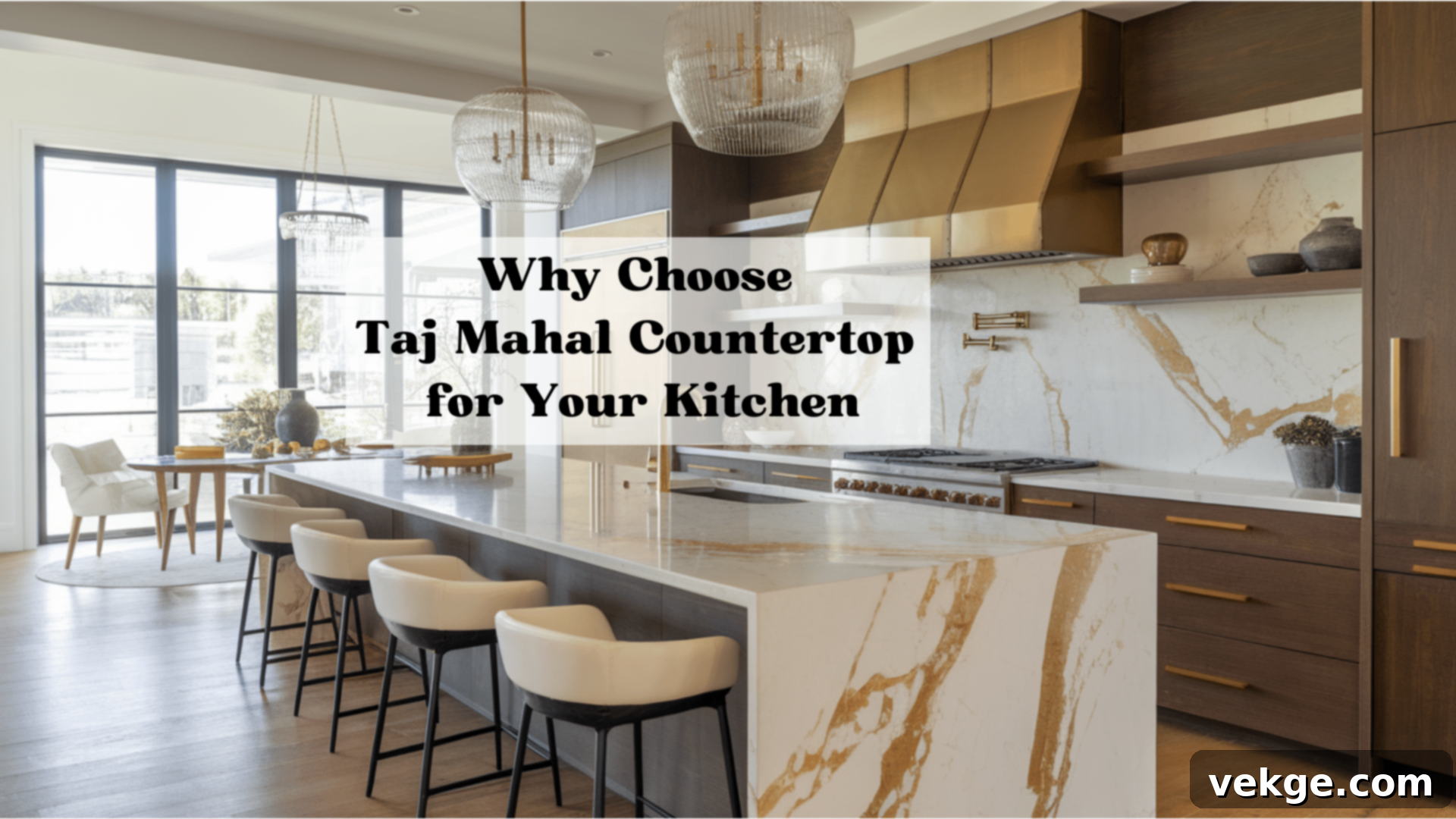Taj Mahal Quartzite Countertops: The Ultimate Guide to Beauty, Durability, and Style
For homeowners envisioning a kitchen that flawlessly blends breathtaking aesthetics with unwavering practicality, Taj Mahal Quartzite has emerged as a premier selection for countertops. This exquisite natural stone is celebrated for its soft white background, elegantly interwoven with subtle gold and warm taupe veins, imbuing any kitchen space with an inviting warmth and a touch of timeless luxury.
Beyond its striking visual appeal, Taj Mahal Quartzite distinguishes itself with remarkable functional benefits. Notably harder and more resilient than many popular alternatives like granite, it is exceptionally well-suited to withstand the rigors of daily kitchen activities. Its superior heat resistance and impressive ability to resist scratches ensure it remains pristine even in the busiest culinary environments. Furthermore, its versatile neutral coloring offers boundless design flexibility, pairing harmoniously with an extensive range of cabinet styles and kitchen aesthetics.
Whether you are undertaking a complete kitchen renovation or building your dream home from the ground up, Taj Mahal Quartzite offers an unparalleled combination of attractiveness and utility, fulfilling the desire for both enduring beauty and practical performance. This comprehensive guide will delve into every essential aspect of this premium countertop option, helping you understand why it could be the perfect foundation for your new kitchen.
What is Taj Mahal Quartzite? Understanding This Premium Natural Stone
Taj Mahal Quartzite is a magnificent natural stone, a true marvel of geological formation, that brings both profound beauty and incredible toughness to kitchen and bathroom spaces. This unique material showcases a clean, soft white to off-white background, gracefully adorned with gentle gold, cream, and sometimes subtle grey veins that flow organically throughout the slab. These delicate patterns provide depth and character, ensuring that each countertop is a one-of-a-kind masterpiece.
Unlike engineered materials or man-made composites, Taj Mahal Quartzite is entirely natural. It is formed through a metamorphic process deep within the earth’s crust, where sandstone, rich in quartz, undergoes intense heat and pressure over millions of years. This extreme geological transformation recrystallizes the quartz grains, making the stone incredibly dense and hard, and distinct from its softer marble counterparts or more porous granites.
Compared to other widely popular natural stones, Taj Mahal Quartzite truly stands out. Its formation process results in a stone that is significantly more durable than granite, exhibiting superior resistance to chipping and cracking – common concerns during the normal hustle and bustle of kitchen use. Moreover, it offers a dramatic advantage over marble; while marble is renowned for its elegance, it is also notoriously susceptible to staining and etching from acidic foods and liquids. Taj Mahal Quartzite, however, boasts a much higher resistance to spills, acids, and common kitchen chemicals, greatly simplifying maintenance and preserving its pristine appearance for years to come.
The advantages of Taj Mahal Quartzite extend far beyond its aesthetic allure. This robust stone can effortlessly handle hot pots and pans placed directly on its surface without fear of damage or discoloration, a vital feature for any active cook. Its inherent hardness also makes it highly resistant to scratches from kitchen utensils, maintaining a smooth, unblemished surface. With minimal upkeep, its timeless beauty remains undiminished, offering a long-term, valuable investment for your home.
Why Choose Taj Mahal Quartzite for Your Kitchen? Unpacking the Key Benefits
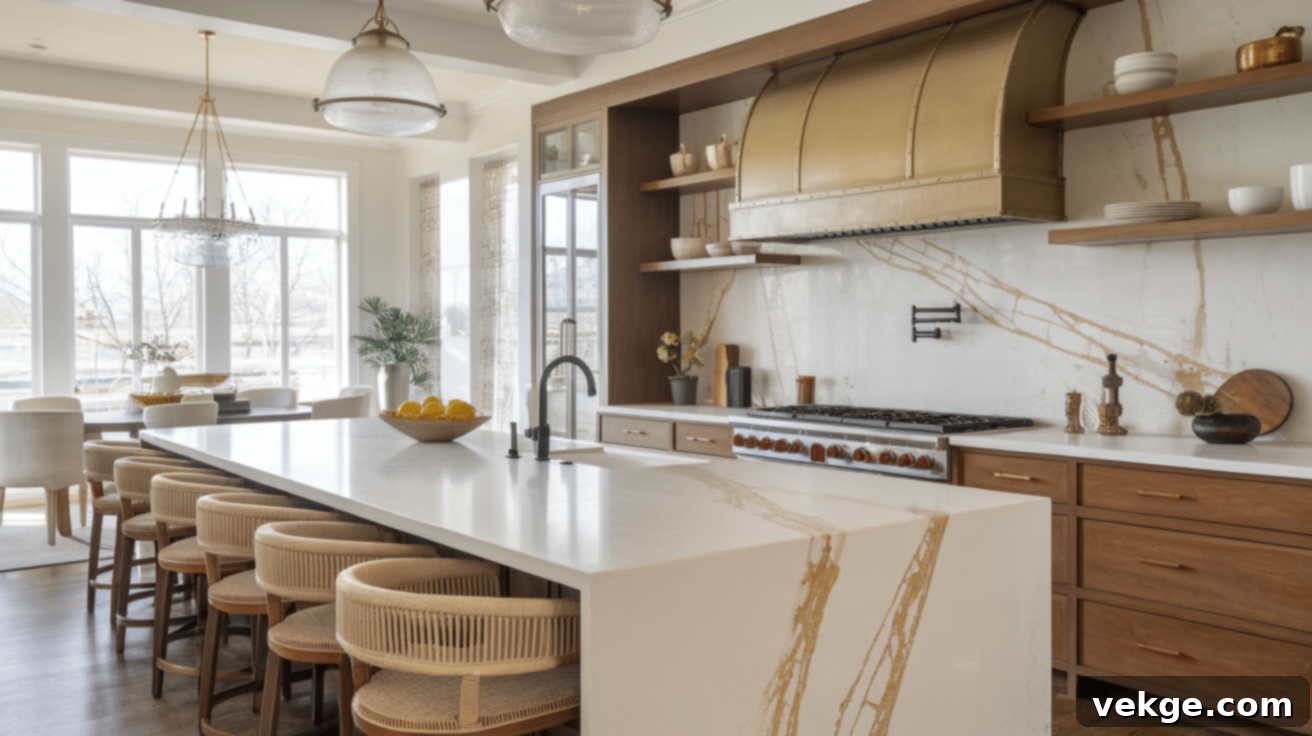
Choosing the right countertop material is a pivotal decision in any kitchen design. Taj Mahal Quartzite provides a compelling suite of practical benefits that firmly establish it as a top contender for your kitchen upgrade, delivering both peace of mind and enduring style.
1. Unrivaled Durability for Active Households
The inherent strength of Taj Mahal Quartzite is arguably its most significant advantage. It stands up exceptionally well to the daily demands and unforeseen accidents that occur in a busy kitchen. Its natural hardness surpasses that of granite, making it extraordinarily resilient to the bumps, impacts, and scrapes that are part and parcel of culinary activities. Imagine children assisting with baking projects, or a lively gathering around your kitchen island – with Taj Mahal Quartzite, you can rest assured that your countertops are far less likely to chip, crack, or suffer significant damage.
For families who rely heavily on their kitchen as the heart of their home, this superior strength translates into fewer worries about everyday wear and tear, and significantly reduces the need for costly repairs or premature replacement, ensuring your investment truly lasts a lifetime.
2. Eye-catching Appeal: A Touch of Sophistication
The aesthetic charm of Taj Mahal Quartzite is undeniable. Its luminous white to creamy background, gracefully accented with warm gold and taupe veins, exudes an aura of understated luxury and sophistication. This elegant color palette ensures that it becomes a focal point without overwhelming the space, seamlessly elevating the entire kitchen’s design. Its neutral yet rich coloring grants it incredible versatility, allowing it to harmonize beautifully with a vast spectrum of cabinet finishes – be it crisp white for a bright, modern look, deep dark tones for dramatic contrast, or warm wood cabinets that echo the golden veins within the stone.
Whether your design vision leans towards clean, contemporary lines, embraces the warmth of traditional styles, or seeks to blend various stylistic elements, Taj Mahal Quartzite integrates perfectly. Many homeowners particularly appreciate how it brightens kitchen spaces, making them feel more open and inviting, while simultaneously adding a subtle yet profound visual interest that draws the eye.
3. Exceptional Heat Resistance: A Cook’s Best Friend
Unlike some countertop materials that can warp, scorch, or develop unsightly marks when exposed to high temperatures, Taj Mahal Quartzite boasts impressive heat resistance. This crucial attribute means you can confidently place warm pots, pans, and baking dishes directly from the oven or stovetop onto its surface without causing damage or discoloration. This quality is particularly invaluable around cooking zones, stovetops, and designated hot zones, where protection from heat is paramount.
Home cooks and culinary enthusiasts will find this characteristic incredibly beneficial, especially during intensive meal preparations or when hosting, eliminating the constant need for trivets and hot pads, and streamlining the cooking process with peace of mind.
Taj Mahal Quartzite vs. Other Popular Countertop Materials
When embarking on the journey of selecting new kitchen countertops, understanding how Taj Mahal Quartzite stacks up against other prevalent options on the market is crucial. This comparison will highlight its unique advantages and help you make an informed decision for your home.
| Feature | Taj Mahal Quartzite | Granite | Marble |
|---|---|---|---|
| Hardness & Durability | Very hard, exceptionally resistant to scratches, chips, and daily impacts. Formed under intense pressure, making it one of the most durable natural stones available for countertops. Ideal for busy kitchens. | Hard, but generally less so than quartzite. Good resistance to scratches and chips, but can be more prone to damage than quartzite under heavy impact. A reliable choice for everyday use. | Softer than both quartzite and granite. More susceptible to scratching, chipping, and etching. Requires more careful handling and protection to maintain its surface integrity. |
| Heat Resistance | Excellent natural heat resistance. Can handle hot pots and pans placed directly on the surface without damage, making it highly practical for active cooking areas. | Good heat resistance. Generally safe for hot items, but prolonged exposure to extreme heat can sometimes cause thermal shock or discoloration if not properly sealed or if there are existing flaws. | Good heat resistance. While it can withstand high temperatures, hot items can sometimes leave “heat rings” or dull spots, especially if the surface is unsealed or has absorbed moisture. |
| Stain Resistance | Very good natural resistance to stains. Its low porosity significantly reduces absorption of liquids, making it less prone to staining from common kitchen spills like wine, oil, and coffee, particularly when sealed. | Requires sealing to effectively resist stains. Unsealed granite is porous and can absorb liquids, leading to permanent stains. Regular, proper sealing is essential for stain prevention. | Poor stain resistance. Highly porous and reacts easily with acidic substances (e.g., lemon juice, vinegar), leading to etching and permanent stains. Requires immediate cleanup and diligent sealing. |
| Price Range | Higher cost. Reflects its superior durability, natural beauty, and the intensity of its geological formation process. Represents a premium, long-term investment. | Mid-range price. Generally more accessible than quartzite or marble, offering a balance of durability and aesthetic appeal for a wider range of budgets. | High cost. Priced similarly to or sometimes higher than quartzite, depending on the rarity and vein patterns. Its elegance comes at a premium. |
| Maintenance | Low maintenance. Occasional sealing (typically every 1-2 years) is recommended to enhance stain resistance. Daily cleaning is simple with mild soap and water. | Moderate maintenance. Requires more frequent sealing (annually or semi-annually, depending on use) to maintain stain resistance. Daily cleaning is straightforward. | High maintenance. Requires frequent sealing (often every 3-6 months) and immediate cleanup of spills to prevent etching and staining. More prone to showing wear and tear over time. |
| Look & Aesthetics | Elegant white/cream background with subtle gold/taupe veins. Offers a luxurious, bright, and sophisticated appearance that complements both modern and traditional designs. Each slab is unique. | Wide variety of colors, patterns, and mineral compositions. Can range from uniform to highly variegated. Offers extensive design flexibility but may lack the soft, consistent elegance of quartzite. | Classic, luxurious veined appearance, often in white, grey, or black. Renowned for its timeless beauty and distinct patterns that add grandeur, but often with a softer, less resilient surface. |
Design Inspiration for Kitchens with Taj Mahal Quartzite Countertops
Visualizing how Taj Mahal Quartzite can transform your space is an exciting part of the design process. Exploring real-world examples and understanding popular pairings can greatly assist in picturing this stunning stone within your own kitchen.
Popular Kitchen Styles Enhanced by Taj Mahal Quartzite
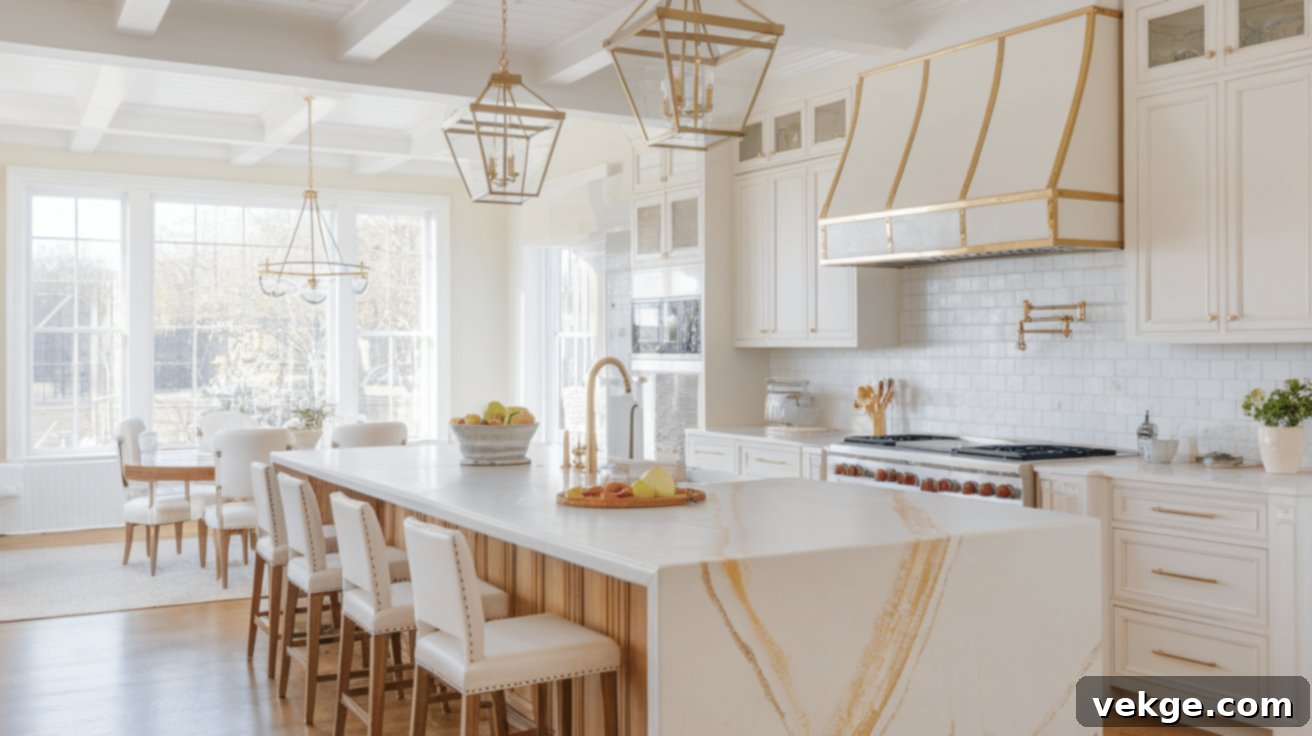
Taj Mahal Quartzite’s versatile beauty allows it to seamlessly integrate into a myriad of kitchen design themes. Its light color and elegant veining make it particularly effective in:
- Modern Farmhouse: Pairing beautifully with rustic wood elements and clean lines, the quartzite adds a touch of refined sophistication.
- Contemporary & Transitional: Its subtle pattern and bright surface contribute to a sleek, uncluttered aesthetic while adding natural texture.
- Traditional: The warm gold tones in the veining complement classic architectural details and rich wood finishes, enhancing a timeless feel.
- Coastal & Scandinavian: The light, airy quality of the stone helps create a serene, open atmosphere, reflective of these minimalist and nature-inspired styles.
Browsing platforms like Houzz and Pinterest often reveals Taj Mahal Quartzite featured prominently in L-shaped layouts or large island designs, where its luminous surface helps to visually expand the space and make it feel more open and bright. Many discerning homeowners choose to extend the quartzite from the countertops up onto the backsplash, creating a continuous, luxurious look, while others prefer to highlight it as a dramatic focal point on a grand kitchen island.
Complementary Cabinet Color Pairings
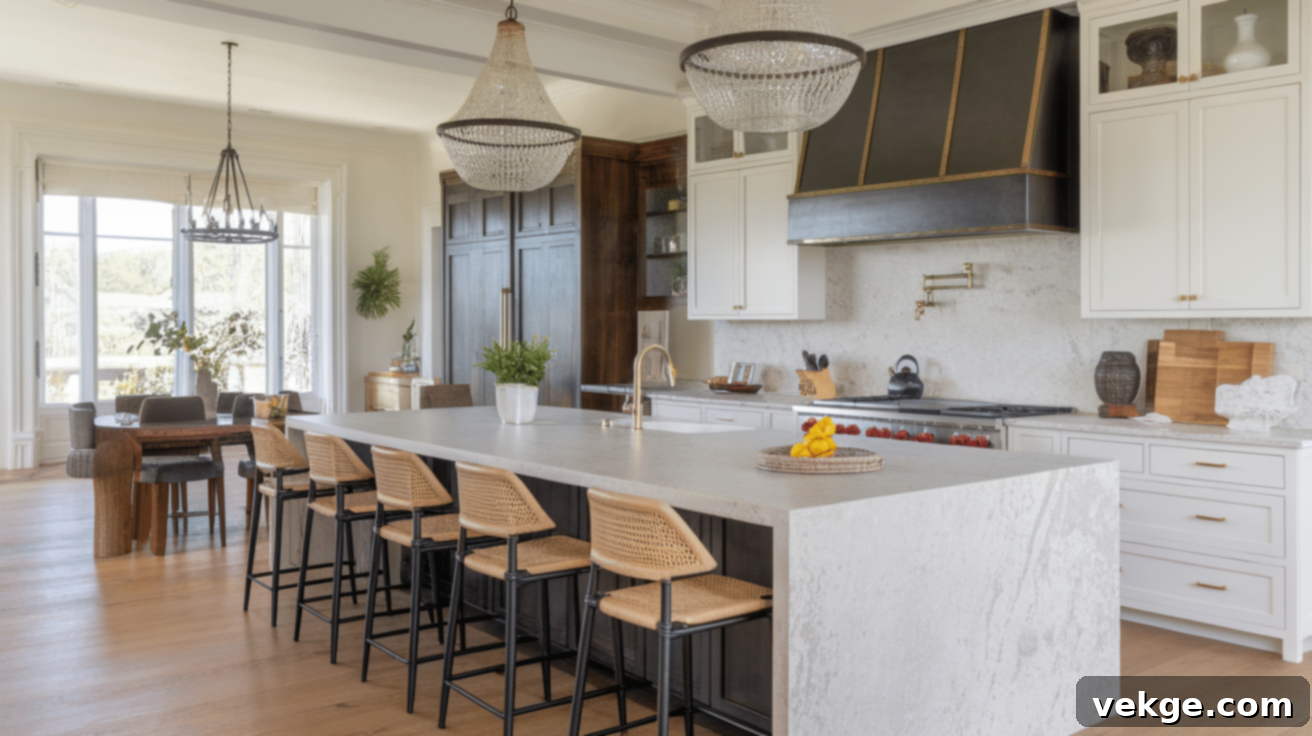
The neutral yet rich tones of Taj Mahal Quartzite offer remarkable flexibility when it comes to cabinet selection. Here are some highly effective pairings:
- White Cabinets: This classic combination creates an exceptionally clean, bright, and expansive look. The subtle gold veins in the quartzite add a layer of warmth, preventing the space from feeling too stark or cold, resulting in an elegant and airy ambiance.
- Dark Cabinets (Navy, Charcoal, Espresso): Opting for dark cabinetry provides a stunning, sophisticated contrast with the light surface of the stone. This pairing creates a dramatic and luxurious feel, allowing the quartzite to truly pop and become the star of the kitchen.
- Wood Cabinets (Natural Oak, Walnut, Cherry): Wood cabinets beautifully complement the warm gold and taupe veins inherent in the Taj Mahal Quartzite. This combination fosters a cozy, inviting, and organic atmosphere, perfect for traditional or modern farmhouse designs.
- Gray Cabinets: Depending on the shade of gray (from light to deep charcoal), this can create a harmonious, contemporary, and sophisticated look, especially when paired with the cooler undertones some slabs of Taj Mahal may possess.
While white cabinets remain a perennially popular choice for their ability to enhance the stone’s brightness, the growing trend of pairing Taj Mahal Quartzite with natural wood cabinetry illustrates its adaptability in creating a warm, grounded, and inviting culinary space.
Harmonizing Backsplash Options
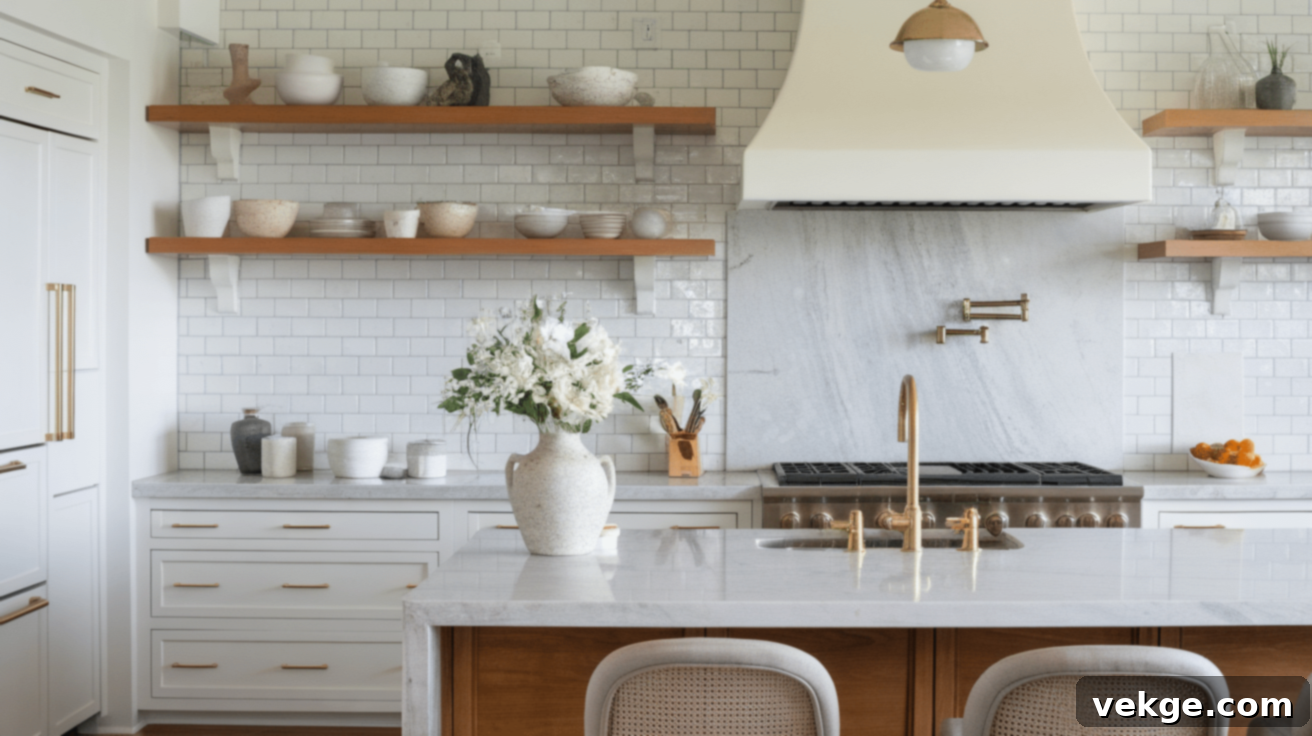
The right backsplash can tie your entire kitchen design together, and with Taj Mahal Quartzite, you have several excellent choices that enhance its natural beauty:
- Matching Quartzite Slab Backsplash: For the ultimate seamless and luxurious look, extending the Taj Mahal Quartzite from the countertop directly up the wall creates a stunning, cohesive statement that is both elegant and easy to clean.
- Simple White Subway Tiles: A timeless choice, white subway tiles offer a clean, crisp backdrop that allows the natural beauty of the quartzite to shine without competition. Various finishes (glossy, matte) can add different textures.
- Glass Tiles in Soft, Neutral Colors: Glass tiles in hues of cream, beige, or very light gray can introduce a subtle shimmer and depth, reflecting light and complementing the stone’s soft tones without overpowering it.
- Porcelain Tiles with Gold or Warm Tones: Selecting porcelain tiles that subtly echo the gold or creamy tones found in the quartzite’s veining can create a sophisticated, harmonious connection between the counter and the wall. Textured or slightly patterned tiles can add interest.
- Honed Travertine or Limestone: For a more earthy, textured, and rustic feel, natural tiles in neutral tones can provide a beautiful contrast to the smooth elegance of the quartzite, enhancing a Mediterranean or Tuscan-inspired kitchen.
The guiding principle for choosing a backsplash with Taj Mahal Quartzite is to select options that enhance and complement, rather than compete with, the stone’s inherent elegance. The goal is a balanced, cohesive, and visually appealing kitchen environment.
Maintenance and Care of Taj Mahal Quartzite Countertops: Keeping Them Pristine
While Taj Mahal Quartzite is celebrated for its exceptional toughness and durability, proper care and maintenance are still crucial to ensure its enduring beauty and to protect your investment for decades to come. Following these simple guidelines will help keep your countertops looking as splendid as the day they were installed.
- Daily Cleaning: For everyday cleaning, use a soft cloth or sponge with mild dish soap and warm water. Wipe down the surface gently, then rinse thoroughly with clean water to remove any soap residue. Finally, dry with a clean, soft cloth to prevent water spots and streaking.
- Prompt Spill Cleanup: Although Taj Mahal Quartzite is highly stain-resistant, it’s always best practice to wipe up spills immediately, especially those involving acidic liquids like lemon juice, vinegar, wine, coffee, or harsh chemicals. While the stone resists etching much better than marble, prolonged exposure can still potentially affect the sealer or the stone’s surface over time.
- Avoid Harsh Cleaners: Steer clear of abrasive cleaners, scouring pads, strong detergents, or products containing bleach, ammonia, or acidic components. These can degrade the sealer, dull the stone’s finish, or potentially etch the surface. Always opt for pH-neutral cleaners specifically designed for natural stone, or simply mild soap and water.
- Tackling Tough Spots: For stubborn grime or sticky residue, a paste made from baking soda and water can be gently applied and scrubbed with a soft cloth. Rinse thoroughly and dry. For truly challenging marks, consult with a stone care professional.
The Importance of Sealing
Despite being denser and less porous than many other natural stones, Taj Mahal Quartzite still benefits significantly from proper sealing to maximize its stain resistance. When first installed, it should be professionally sealed. Following this initial treatment, it is generally recommended to reseal your Taj Mahal Quartzite countertops every 1-2 years, depending on usage and the type of sealer applied. In high-traffic kitchens or areas prone to spills, more frequent sealing might be beneficial.
To check if sealing is needed: Conduct a simple water test. Place a few drops of water on a clean, dry section of your countertop. If the water beads up and stays on the surface, your sealer is likely still effective. If the water quickly soaks into the stone and darkens the area, it’s a clear indication that it’s time to reseal your countertops.
Protecting Your Investment
Even with its impressive attributes, practicing sensible protection habits will ensure the longevity and pristine condition of your Taj Mahal Quartzite:
- Use Cutting Boards: While quartzite is highly scratch-resistant, it’s harder than your knife blades. Always use a cutting board to protect both your countertops and your knives.
- Employ Trivets and Hot Pads: Although the stone is remarkably heat-resistant, placing extremely hot items directly on the surface can still cause thermal shock or affect the sealant over a very long period. It’s always prudent to use trivets or hot pads, especially for items fresh from the oven or stovetop.
- Avoid Heavy Impacts and Dragging: While incredibly tough, no stone is entirely indestructible. Avoid dragging heavy or abrasive objects across the counter, which could potentially cause surface abrasions. Be mindful of dropping heavy pans or objects, especially near sink cutouts or unsupported edges, where the stone might be more vulnerable to chipping or cracking.
By integrating these simple yet effective care routines into your kitchen maintenance, your Taj Mahal Quartzite countertops will continue to be a stunning, functional, and resilient centerpiece in your home for many years to come.
Mistakes to Avoid with Taj Mahal Quartzite Countertops
Even with its inherent strength and captivating beauty, Taj Mahal Quartzite, like any premium surface, requires proper attention to avoid common pitfalls that can diminish its appeal and longevity. Being aware of these mistakes can help you maintain your countertops in pristine condition.
Not Sealing Properly or Neglecting Resealing
One of the most frequent and costly mistakes homeowners make is either skipping the initial sealing process for their Taj Mahal Quartzite or delaying subsequent resealing. While quartzite is naturally dense, it is not entirely non-porous. Without a high-quality sealer, the stone can gradually absorb liquids, oils, wine, coffee, and food dyes, leading to permanent and difficult-to-remove stains. Improper application of a sealer, such as not covering the entire surface evenly or failing to allow adequate drying and curing time, significantly reduces the protective barrier’s effectiveness.
Solution: Ensure your countertops are professionally sealed upon installation. Regularly perform the water droplet test to assess the effectiveness of your sealant (as described in the “Maintenance” section) and commit to resealing every 1-2 years or as recommended by your stone professional. This proactive approach is the single most important step to prevent staining.
Ignoring Daily Maintenance and Prompt Spill Cleanup
Some homeowners, confident in Taj Mahal Quartzite’s robust nature, mistakenly believe it requires little to no upkeep. This misconception can lead to accumulated grime, dullness, and potential surface damage over time. Allowing spills, particularly acidic ones, to sit for extended periods can wear away the sealer and potentially etch the stone, especially if the sealer is compromised. Similarly, using harsh, abrasive, or acidic cleaners can prematurely strip the sealant, leaving the stone vulnerable and dulling its natural luster.
Solution: Implement a simple daily cleaning routine using mild soap and water, and always wipe up spills immediately. Embrace the habit of using pH-neutral cleaners specifically designed for natural stone. Consistent gentle care is far more effective and less damaging than sporadic, aggressive cleaning after neglect.
Overloading or Misusing the Countertop
While Taj Mahal Quartzite is remarkably stronger than many other natural stones, it is not invulnerable to extreme pressure or impact. Placing excessive weight on unsupported edges (such as an overhang without adequate bracing) or using the countertop as a stepping stool can create stress points that may lead to cracks. Similarly, repeated heavy impacts, like dropping cast-iron pans or heavy appliances, particularly near vulnerable areas like sink cutouts or corners, can result in chips or fractures.
Solution: Always be mindful of weight distribution. Position heavy appliances like stand mixers or coffee makers over cabinet supports. Avoid standing or climbing on your countertops. Exercise caution with heavy objects; gently place them rather than dropping them, and be extra careful around cutouts where the stone’s integrity is slightly reduced. While incredibly durable, treating your countertops with respectful care will prevent accidental damage and preserve their flawless appearance.
Conclusion: Investing in the Timeless Elegance and Durability of Taj Mahal Quartzite
In the realm of premium kitchen countertops, Taj Mahal Quartzite stands as an unparalleled choice, offering a perfect harmony of enduring beauty and exceptional practicality. Its luminous white to creamy background, gracefully adorned with warm gold and taupe veins, infuses any kitchen design with an instant sense of light, warmth, and sophisticated luxury. This natural stone is not merely a surface; it’s a statement piece that enhances the overall aesthetic and value of your home.
Distinguishing itself with superior durability, Taj Mahal Quartzite significantly outperforms granite in terms of hardness and resistance to chipping, while offering vastly improved practicality over marble, especially concerning stain and etch resistance. It is meticulously engineered by nature to handle the demanding realities of busy kitchens, effortlessly shrugging off heat, scratches, and everyday wear and tear, all while maintaining its pristine good looks and elegant finish.
With proper care and diligent maintenance, including appropriate sealing and gentle daily cleaning, Taj Mahal Quartzite countertops are a remarkably resilient and long-lasting investment. They are designed to withstand the test of time, ensuring that your kitchen remains a focal point of beauty and functionality for many years, even decades, to come.
Before finalizing your decision, we highly recommend taking the time to view full slabs of Taj Mahal Quartzite in person. This allows you to truly appreciate the unique variations in veining and color that make each slab distinctive. Furthermore, consulting with experienced stone professionals and reputable fabricators is invaluable. They can provide personalized advice tailored to your specific kitchen needs, discuss installation considerations, and answer any lingering questions, ensuring you make an informed choice. A professional installer will guarantee your new Taj Mahal Quartzite countertops are perfectly set up for years of exquisite enjoyment and peace of mind.
